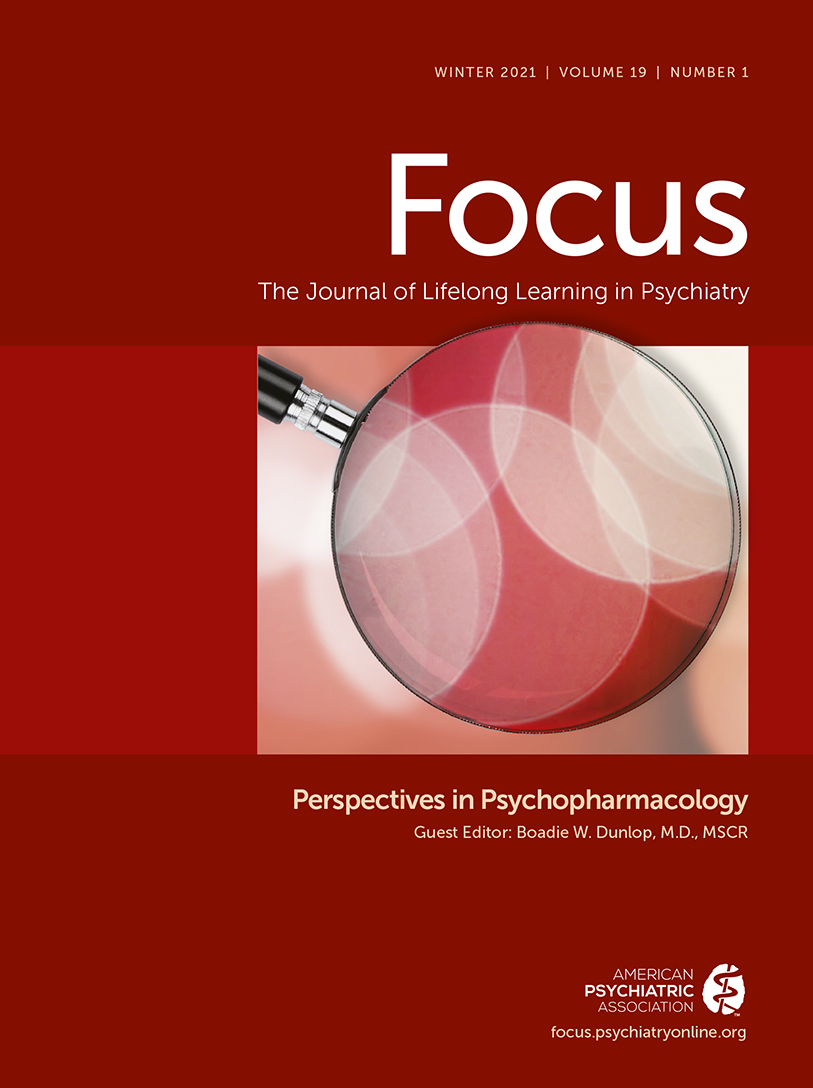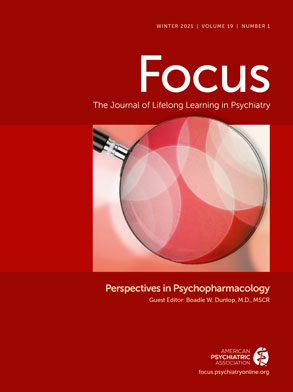Flibanserin.
Flibanserin (Addyi) was approved in 2015 by the U.S. Food and Drug Administration (FDA) for treatment of generalized acquired HSDD among premenopausal women.
Its mechanism of action is exerted through serotonin 1A (5HT1A) receptor agonism and serotonin 2A (5HT2A) receptor antagonism. This process reduces serotonin inhibition of excitatory neurotransmitters and thus indirectly increases release of dopamine and norepinephrine (
33,
34).
Three randomized, double-blind, placebo-controlled trials demonstrated that flibanserin was efficacious for HSDD symptoms compared with placebo (
35–
37). All three studies were conducted among premenopausal women, and all were 24 weeks long. Efficacy was measured with the Female Sexual Function Index desire subscale (FSFI-D); Female Sexual Distress Scale–Revised Item 13 (FSDS-R13), which measures distress associated with sexual desire; and Satisfying Sexual Events (SSE), as determined by the woman. All efficacy endpoints in the phase 3 studies demonstrated statistical significance in change from baseline to endpoint over placebo. Relative to placebo, flibanserin had an effect size of 0.29–0.44 (desire) and 0.24–0.44 (distress). Improvement was seen after 4 weeks of daily dosing. One study found that 50 mg given at bedtime was efficacious (
36); however, another study did not find this dose to separate from placebo (
35). All studies found that 100-mg daily dosing was effective in approximately 50% of women. Responders found the effect to be clinically meaningful.
A 52-week open-label extension study found that flibanserin was safe and well tolerated. Sexual function improved among participants who were initially nonremitters and was maintained over time in remitters (
38).
Even though flibanserin is not indicated for postmenopausal women, evidence suggests that it is also effective among this population (
39). The recommended dose is 100 mg given once daily at bedtime. When assessing for improvement, one should inquire about changes in sexual desire, reduction in distress related to sexual dysfunction, and satisfaction with the treatment. If no improvement occurs after 8 weeks, one should consider discontinuing this medication.
Flibanserin is safe to use concomitantly with SSRIs and SNRIs. A small randomized, placebo-controlled trial demonstrated no serious adverse effects and no instances of suicidal ideation and behavior when combining flibanserin 100 mg daily with a stable SSRI or SNRI treatment regimen (
40).
The most common adverse reactions (incidence≥2%) include dizziness, somnolence, nausea, fatigue, insomnia, and dry mouth. Hypotension and syncope have been reported, and its package insert has a warning for these conditions (
41).
Previously, concomitant use with alcohol was contraindicated and required a risk evaluation and mitigation strategy (REMS) because of concerns for orthostatic hypotension and syncope. Studies have demonstrated that it is safe to use flibanserin with alcohol. Taking this medication 2, 4, and 6 hours after ethanol consumption did not increase the incidence of hypotension, orthostatic hypotension, or syncope compared with flibanserin or ethanol alone (
42–
44). Thus, the REMS program was discontinued, and the label was changed to recommend not using flibanserin within 2 hours of alcohol consumption.
Flibanserin does not appear to prolong the corrected QT interval (
41). It is primarily metabolized by cytochrome P450 3A4 (CYP3A4) and cytochrome P450 2C19 (CYP2C19); therefore, one should review the patient’s medication list for moderate and strong inhibitors or inducers of these enzymes. The risk of severe hypotension is increased with CYP3A4 inhibitors. Examples of strong CYP3A4 inhibitors include clarithromycin, HIV protease inhibitors, ketoconazole, and grapefruit juice. Strong inducers of CYP3A4 include phenytoin, phenobarbital, rifampin, carbamazepine, and St. John’s wort. Strong inhibitors of CYP2C19 include fluoxetine, fluvoxamine, proton-pump inhibitors, antifungals, and benzodiazepines.
Flibanserin can increase the concentration of drugs transported by P-glycoprotein (P-gp). It is recommended to increase monitoring of concentrations of drugs transported by P-gp that have a narrow therapeutic index, such as digitalis and rapamycin.
The use of flibanserin is contraindicated in hepatic impairment because there is a 4.5-fold increase to flibanserin exposure in this population. Its use in pregnancy and breastfeeding has not been studied; therefore, it is not recommended.
Currently, this medication costs $99 per month without insurance. However, discounts as low as $20 per month for patients with commercial insurance can be found at
https://addyi.com/howtosave.
Bremelanotide.
Bremelanotide (Vyleesi) was approved in 2019 by the FDA for treatment of generalized acquired HSDD among premenopausal women.
Bremelanotide is a melanocortin 4 receptor (MC4R) agonist. Neurons expressing the MC4R are present throughout the central nervous system (
45). The mechanism by which bremelanotide improves HSDD is unknown, but it is thought to increase excitation by enhancing dopamine and norepinephrine activity.
The FSFI-D, item 13 of the Female Sexual Distress Scale-Desire/Arousal/Orgasm (FSDS-DAO), and SSE were also used in the phase 3 studies and demonstrated that bremelanotide is significantly more effective than placebo (
46). The combined effect size for the two phase 3 studies relative to placebo was 0.39 for FSFI-D and 0.27 for FSDS-DAO item 13. The response rate for bremelanotide was 58.2% versus 35.6% for placebo in the integrated phase 3 data set. This response was considered clinically meaningful by the study participants. An extension study also showed that after 52 weeks, response to this medication was maintained (
47).
The recommended dose is 1.75 mg administered subcutaneously in the abdomen or thigh via an autoinjector, on an as-needed basis. Patients should inject the medication at least 45 minutes before a sexual encounter. It is not recommended to use more than one dose within 24 hours, or more than eight doses within 1 month.
As with flibanserin, one should inquire about changes in sexual desire, reduction in distress related to sexual dysfunction, and satisfaction with the treatment to assess for treatment response. If no improvement occurs after 8 weeks, one should consider discontinuing this medication.
The most common adverse reactions (incidence≥4%) include nausea, flushing, headache, vomiting, and adverse site reactions. Nausea is the most common adverse reaction. In placebo-controlled trials, 40% of patients receiving bremelanotide reported nausea compared with 1% of patients receiving placebo. Hyperpigmentation of the face, gingiva, and breasts has also been reported (
48).
Bremelanotide can cause transient increases in blood pressure, and it is contraindicated in uncontrolled hypertension. Providers should consider the patient’s cardiovascular risk and ensure that blood pressure is well controlled.
Of note, bremelanotide can significantly decrease the absorption of oral naltrexone, and its concomitant use is not recommended. The use of intramuscular naltrexone can be an alternative for this subset of patients.
Testosterone.
Although approved in Europe for treatment of HSDD among women with surgical menopause, it is an off-label treatment option in the United States. Studies on testosterone for HSDD have been largely conducted among women who have undergone natural or surgical menopause. Evidence is lacking for premenopausal women, and should a woman become pregnant, fetal exposure may be associated with significant negative consequences.
Three randomized, double-blind, placebo-controlled trials have shown that a 300-μg/d transdermal testosterone patch was superior to placebo in improving symptoms of HSDD. Women who received this medication reported improvement in satisfying sexual events as well as a decrease in levels of distress. Lower testosterone doses were not effective (
49–
52). This product was not approved in the United States because of lack of information about long-term consequences. These concerns have not been borne out in use in other countries.
Transdermal use is recommended. Oral or intramuscular preparations are not recommended because of high variability of absorption, which typically achieves supraphysiologic levels and increases the risk of adverse effects.
Improvement of symptoms is expected within the first 3 months of treatment. If the patient does not experience improvement in symptoms after 3–6 months, consider discontinuing treatment (
53).
The most common side effects are acne, application site reactions, breast pain, headache, and hirsutism. In several studies, liver function, lipid profile, hematologic tests, and clotting measures remained essentially unchanged (
49–
52).
Baseline and follow-up testosterone levels should be obtained. Levels should be maintained within normal ranges. Short-term safety data are reassuring when testosterone levels are maintained within normal levels (
54). However, long-term data are limited to observational studies, including safety data with regard to breast cancer and cardiovascular events (
55).
Testosterone formulations for women are not widely available. Most clinicians will have to use topical formulations for men but at a much lower dose, generally one-seventh to one-tenth of approved doses for men to avoid virilization. Compounded formulations are another option.


